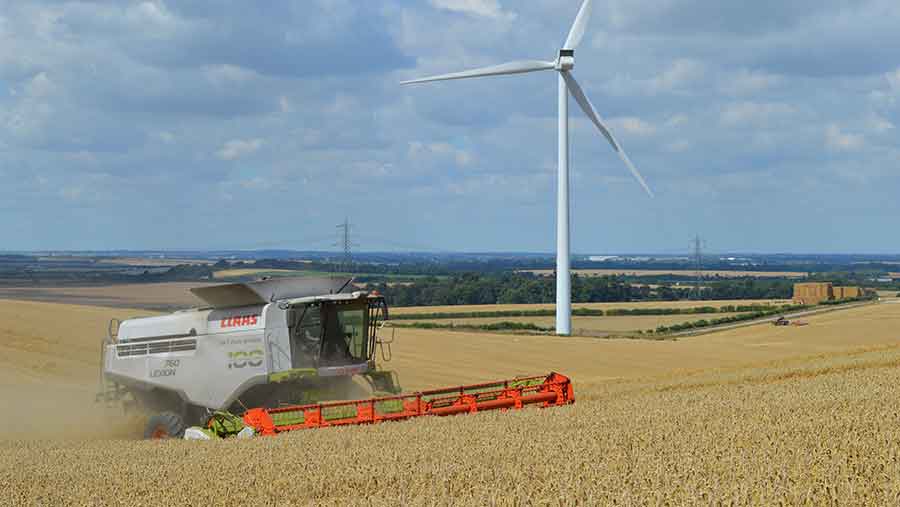Harvest 2016: Wheat quality looks good as yields take a dip
Milling wheat quality is looking good from early-cut crops in the South and East of England as many growers see yields below long-term farm averages.
Harvested wheat is showing slightly smaller grains than last summer, which has led to a concentration of protein giving levels generally above the 2015 harvest.
The majority of early wheat loads into store are showing promising quality, but traders warn that these are only early indications with growers in southern England busy cutting wheat in generally good weather.
See also: Video: Wiltshire wheat fears as oilseed rape harvest rolls on
“The wheat harvest is looking pretty good at the moment and quality is very encouraging,” says Rob Munro, managing director of eastern England co-operative Fengrain.

Andrew Tetlow’s wheat harvest
Early crops show specific weight of 77kg/hl compared with 80kg/hl last year, leading to protein concentration to give a higher level of 13.5% compared with 12.9% last year, he adds.
The majority of milling crops are meeting breadmaking standards of 13% protein, specific weight of 76kg/hl and Hagberg of 250, although some point to more variable protein levels.
Philip Darke, managing director of fellow co-operative Camgrain, says protein levels have ranged between 11 and 14%, but that specific weights and Hagberg are good.
Growers report that early signs show that the wheat harvest will not be as bad as winter barley and oilseed rape, which suffered from low yields and small grains and seeds, which growers blame largely on the lack of sunlight in June.
Good quality
Andrew Tetlow, partner at AWT Farming, had cut 80ha of milling variety Skyfall by Monday evening (8 August) with protein contents of 13.2-14.2% and specific weights of 77-78kg/hl.
“We are very pleased with the quality of the Skyfall at the moment, but it is still very early days,” he tells Farmers Weekly. Yields of Skyfall were about 9.5t/ha against a long-term farm average of 10t/ha.
The lowest Hagberg on the Skyfall was 270 with most about 350, while about 110ha of the feed variety Diego has been cut with yields and specific weights similar to the Skyfall.
His wheat harvest started on Sunday 31 July with Edgar milling wheat grown as a second wheat on lighter land at Wadlow Farm, just east of Cambridge, and averaged 9t/ha across about 60ha.
The group grows about 1,400ha of predominantly milling wheat comprising Edgar, Skyfall and Crusoe, along with Diego, across 2,000-plus hectares of land it farms in Cambridgeshire, Essex and Suffolk.
Optimistic about quality
Hertfordshire grower Andrew Bott finished off 85ha of Skyfall winter wheat earlier this week with yields about 9t/ha, and is optimistic the milling quality will be good.
“Wheat is about where I would expect it to be, and with a good sample we are hopeful the quality will be good,” he says.
Mr Bott farms 600ha of chalky soils with clay caps at Finches Farm, Benington, just east of Stevenage, but he had no figures yet on protein, specific weights and Hagbergs.
He added that combining was going well with grain moisture levels down at 14.5%, while has has 90ha of Zulu biscuit wheat and some spring barley still to cut.
Yield down 10% in Norfolk
Mark Means in north-west Norfolk is seeing yields down after cutting a quarter of his 480ha of mainly milling wheats, largely due to low specific weights.
“We are 10% down in yield, so there is no bumper crop,” he says from his farm at The Laurel, Terrington St Clement, close to The Wash.
Yields of varieties Cordiale and Gallant are about 10-10.5t/ha, 10% down on the five-year farm average, with specific weights of 75-76kg/hl compared with the 78-84kg/hl level, which he is targeting.
Protein contents ranged either side of 13% with Hagbergs about 250-280.
Worries in Wiltshire
Further west, Wiltshire grower David Butler is worried about wheat quality as he sees shrivelled grains a potential problem after rubbing out some ears of the milling variety Crusoe.
“I have been quite concerned at the levels of ear disease in the wheat, so I am fearful for the yields and quality. I suspect the wheat will continue the trend of underwhelming yields – there appears to be quite a few pinched grains,” he says.
Mr Butler farms 870ha at Martinsell House, Wootton Rivers, just south of Marlborough, and has seen “underwhelming” yields this summer of winter barley and oilseed rape.
Yields of winter barley and oilseed rape tumble
Winter barley yields were down nearly 5%, or 0.43t/ha, across 10 AHDB Recommended List trial sites with the six-row barleys outperforming the two-row varieties.
The yield average of 8.88t/ha from this summer, compares with a five-year average of 9.31t/ha. The six-row varieties Bazooka and Belfry were the top yielders, with Orwell being the highest two-row feed variety.
Oilseed rape yields were nearly 9% lower, or almost 0.5t/ha, in the first three oilseed rape AHDB Recommended List trials.
The gross output for the trial sites in Kent, Suffolk and Herefordshire averaged 5.1t/ha compared with a four-year average of 5.59t/ha.

